Why is Iceland consistently ranked as one of the world's top travel destinations? Plan a trip to this Nordic island nation and discover firsthand what makes Iceland such a popular place to visit.
Iceland is one of the most captivating travel destinations in the world. For those based in Norway, it's also surprisingly accessible.
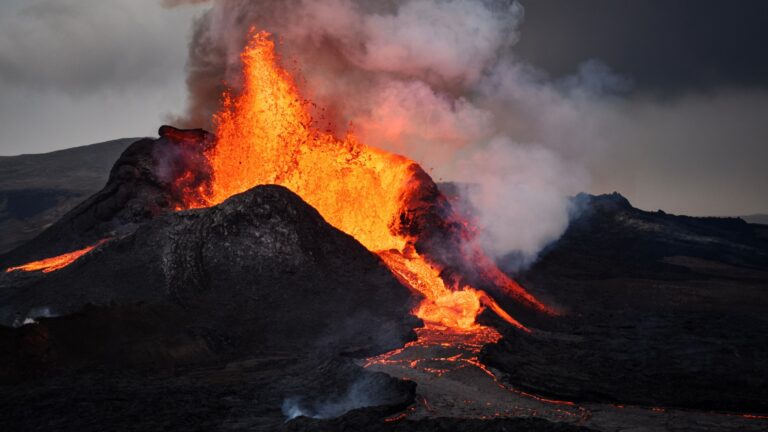
With frequent direct flights from Oslo, Bergen, and Trondheim, exploring the land of fire and ice can be a seamless addition to your Nordic travel plans.
This remarkable island offers a striking contrast to Norway’s familiar scenery. Here, steaming geothermal springs bubble beneath vast lava fields, black sand beaches stretch along dramatic coastlines, and glaciers carve their way through volcanic valleys.
All of it is wrapped in a rich cultural heritage that dates back to the Viking Age, giving Iceland a timeless, otherworldly atmosphere.
From the lively capital of Reykjavík, where colourful street art and cutting-edge architecture reflect a confident creative spirit, to the untouched, remote beauty of the Highlands and the windswept cliffs of the Westfjords, Iceland offers some of the most unforgettable landscapes in Europe.
Why Visit Iceland?
Iceland is a destination that truly offers something for everyone, no matter the season. The best time to visit Iceland depends very much on your desired experience.
🇮🇸 Iceland Travel Resources: If you're planning a trip to Iceland, whether from Norway or something else, check out these recommended resources.
🛏️ Hotel Bookings in Reykjavik and beyond
🚘 Car Rental to explore the wonders of Iceland
👣 Tours & Experiences to make the most of limited time
🚨 Travel Insurance in case the worst should happen
Summer brings endless daylight and countless hiking opportunities across moss-covered lava fields and rolling hills. In winter, darkness descends, but with it comes the magic of the northern lights, dancing across the sky in shades of green and violet.
Those seeking adventure will find it in abundance. It's possible to hike on ancient glaciers, snorkel in the crystal-clear waters between continental plates at Þingvellir, or venture into the raw, rugged interior on a guided 4×4 tour.

For travellers more interested in relaxation, Iceland’s many geothermal pools offer a warm welcome.
Whether soaking in the iconic Blue Lagoon or discovering quieter gems like the Secret Lagoon or Mývatn Nature Baths, there's something uniquely soothing about Iceland’s geothermal culture.
Urban charm adds another layer of appeal. From its thriving food scene and fascinating museums to its distinctive landmarks like modernist church Hallgrímskirkja, Reykjavík may be small, but it’s full of surprises.
Beyond the capital, dramatic fjords, puffin-filled cliffs, and hidden waterfalls offer quiet moments of awe in every corner of the country.
Wherever you go, Iceland reveals its magic gradually. It’s a country that rewards curiosity, encourages exploration, and leaves a lasting impression with its raw beauty and resilient spirit.
Visit Reykjavik
Iceland’s compact yet dynamic capital is the perfect introduction to the country’s culture, creativity, and close relationship with nature. Despite its small size, the city of Reykjavik offers a surprisingly rich city experience, balancing forward-thinking innovation with deep-rooted history.
Architecture and Design
Reykjavik is a city that wears its creativity on its sleeve. Its streets are lined with colourful houses, public art installations, and striking examples of contemporary architecture.

Among the most iconic is Harpa Concert Hall, a cultural landmark on the edge of the harbour. With its shimmering glass façade inspired by Iceland’s basalt formations, Harpa reflects both the natural landscape and the city’s commitment to design and the arts.
It hosts regular concerts, theatre performances, and international festivals, making it a focal point for Reykjavik’s cultural life.
Another unmissable structure is Hallgrímskirkja, the monumental church that rises over the city skyline.
Designed to resemble lava flows, this Lutheran church offers one of the best panoramic viewpoints in Reykjavik from its tower. The interior is minimalist and serene, echoing the Icelandic landscape in both spirit and tone.
History and Culture
To understand Iceland’s story, a visit to the National Museum of Iceland is essential. Located within easy walking distance of the city centre, the museum houses a compelling collection of artefacts, from Viking-era tools and weapons to religious relics and everyday objects from more recent centuries.
The exhibitions paint a vivid picture of how Icelanders have adapted to their environment and preserved their unique identity over the centuries.
The nearby Árbær Open Air Museum also offers a deeper glimpse into Reykjavik’s past, with historic buildings and costumed interpreters bringing old Icelandic ways of life to life, especially during the summer months.
Life by the Sea
Reykjavik’s coastal setting is part of its charm. The Old Harbour district has transformed from a working port into a lively area full of restaurants, cafés, galleries, and marine tour operators.

Whale watching tours depart daily from here, offering the chance to see humpbacks, orcas, and minke whales in their natural environment, depending on the season.
A walk along the waterfront promenade reveals more of Reykjavik’s personality. Visitors often pause at the Sun Voyager sculpture, a dreamlike steel structure that resembles a Viking ship and serves as a tribute to exploration and freedom.
On clear days, the view across the bay towards the distant mountains is breathtaking.
Everyday Reykjavik
Beyond the major sights, Reykjavik’s streets and public spaces invite casual discovery. Laugavegur, the city’s main shopping street, is home to independent boutiques, cosy coffee shops, and lively bars.
Parks and public squares often host outdoor events and pop-up markets, especially in summer, when the midnight sun keeps the city alive well into the night.
Easy Day Trips From Reykjavik
Short on time? Reykjavik offers several day trip opportunities for those with limited time but who are still keen to explore Iceland's rich landscapes and cultural heritage.
The Golden Circle
A popular tourist route, the Golden Circle includes three major attractions: Thingvellir National Park, Geysir Geothermal Area, and Gullfoss Waterfall.
Thingvellir National Park, a UNESCO World Heritage site, is significant for its historical and geological importance. Visitors can walk between the tectonic plates of North America and Eurasia and explore the site of Iceland's first parliament.
🇮🇸 Iceland Travel Resources: If you're planning a trip to Iceland, whether from Norway or something else, check out these recommended resources.
🛏️ Hotel Bookings in Reykjavik and beyond
🚘 Car Rental to explore the wonders of Iceland
👣 Tours & Experiences to make the most of limited time
🚨 Travel Insurance in case the worst should happen
The Geysir Geothermal Area is home to Strokkur, a geyser that erupts every few minutes, sending a column of hot water into the air. Gullfoss, or “Golden Falls,” is a magnificent waterfall that offers stunning views and photographic opportunities.
The Blue Lagoon
Located a short drive from Reykjavik, the Blue Lagoon is a world-famous geothermal spa. The milky-blue waters, rich in minerals, are believed to have healing properties.

Visitors can soak in the warm waters, enjoy spa treatments, and dine at the on-site restaurant.
Recent volcanic activity in the area has seen the Blue Lagoon closed at short notice, so do check in advance before you travel. There are many geothermal spas available in Iceland, so it's a good idea to research some alternatives, just in case.
Snæfellsnes Peninsula
Often referred to as “Iceland in Miniature,” the Snæfellsnes Peninsula is one of the most rewarding places to visit in the west of the country.
It offers an astonishing variety of landscapes packed into a relatively compact area, making it an ideal destination for travellers with limited time who still want to experience the full range of Iceland’s natural beauty.
The peninsula’s defining feature is the Snæfellsjökull glacier, a snow-capped volcano that rises majestically above the surrounding lava fields. This glacier-volcano is shrouded in myth and mystery, famously serving as the gateway to the Earth's core in Jules Verne’s classic novel Journey to the Center of the Earth.
On a clear day, the glacier is visible from Reykjavik across Faxaflói Bay, and many visitors are drawn here for both the dramatic scenery and the sense of literary adventure.
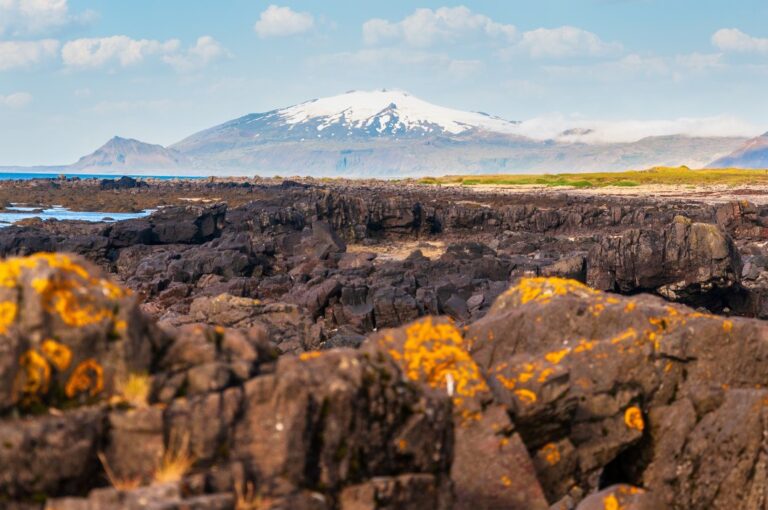
On the southern coast, the seaside village of Arnarstapi is known for its striking basalt cliffs, sea arches, and birdlife. A coastal walking path connects Arnarstapi to Hellnar, offering spectacular views of the rugged coastline along the way.
Inland, moss-covered lava fields stretch across the landscape, remnants of long-past eruptions that have shaped the land into a wild, almost lunar terrain.
To the north, the colourful harbour town of Stykkishólmur serves as a cultural hub of the region. The town is a pleasant place to spend a night or take a boat tour through the nearby Breiðafjörður Bay, known for its countless small islands and rich birdlife.
One of the most photographed spots on the peninsula is the black church of Búðir. Sitting in near isolation on a windswept lava field, with the mountains and glacier rising in the distance, the stark simplicity of the church leaves a lasting impression.
Iceland’s Westfjords
In the remote northwest of Iceland, the Westfjords offer some of the country’s most dramatic and untouched landscapes. Towering mountains, deep fjords, and narrow peninsulas create a rugged terrain shaped by centuries of isolation.
The winding coastal roads reveal awe-inspiring scenery at every turn, with quiet fishing villages tucked into sheltered coves and cliffs that plunge into the North Atlantic.
Among the region’s natural highlights is Dynjandi, a majestic waterfall often described as the jewel of the Westfjords. Its wide, cascading form tumbles down the mountainside in stages, with a short trail allowing visitors to approach its thunderous beauty on foot.
Wildlife is abundant in this part of Iceland. The Hornstrandir Nature Reserve, reachable only by boat, offers a true wilderness experience with no roads or permanent residents.
Here, Arctic foxes roam freely, seabirds nest along the cliffs, and seals lounge along the shoreline.
The town of Ísafjörður, the largest settlement in the region, serves as a gateway for exploring the surrounding fjords and wilderness. Ísafjörður has a charm of its own, with colourful wooden houses, a small but lively arts scene, and local restaurants serving fresh fish and regional delicacies.
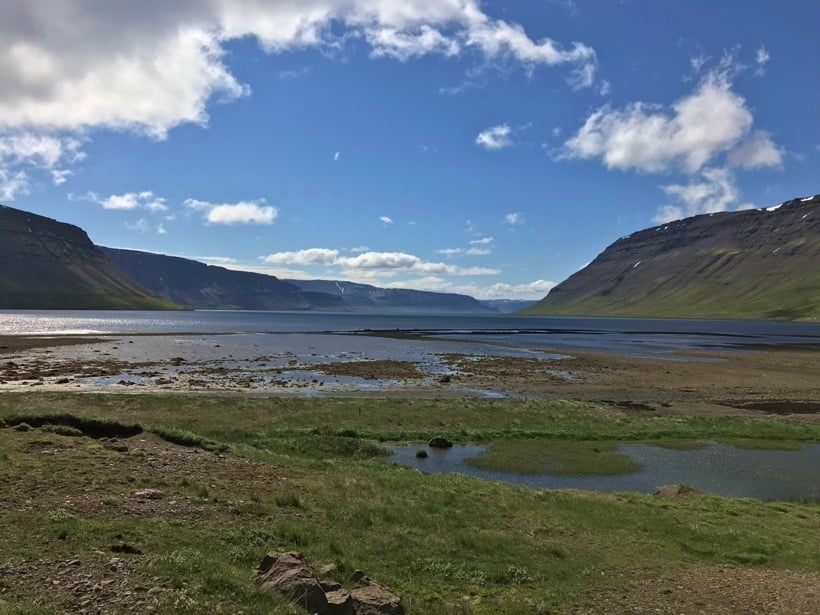
Museums such as the Westfjords Heritage Museum help visitors understand the area’s seafaring history and the resilience of the people who have called this challenging environment home for centuries.
Iceland’s Highlands
The Highlands of Iceland form a vast, untamed wilderness at the heart of the island, covering much of the interior.
Uninhabited and largely inaccessible for most of the year, this rugged region opens up only in the summer months, when snow retreats and specially equipped 4×4 vehicles can navigate the rough gravel roads.
Those who venture here are rewarded with some of the most surreal and otherworldly landscapes in the country.
This raw terrain is shaped by ancient volcanic activity and ongoing geological forces. Black sand deserts, steaming lava fields, glacial rivers, and vibrant geothermal areas combine to create a sense of being on another planet.
The Highlands have an elemental power that contrasts sharply with Iceland’s coastal beauty, offering travellers a deeper look into the forces that shaped the island.
Among the most popular destinations is Landmannalaugar, a geothermal area famed for its colourful rhyolite mountains, steaming fumaroles, and natural hot springs. The area is also a starting point for several renowned hiking trails, including the multi-day Laugavegur trail to Þórsmörk.
Another standout is Askja, a remote volcanic caldera surrounded by dramatic lava fields. Within it lies Víti, a striking blue crater lake warm enough for a cautious dip, although swimming is not officially encouraged.
Exploring the Highlands means embracing adventure. Hiking and wild camping are popular ways to experience the solitude, while guided 4×4 tours offer access to more remote areas without the need for specialist driving skills.
Iceland’s Eastfjords
Tucked between towering mountains and the sea, Iceland’s Eastfjords offer a quieter, more reflective experience.
This less-visited region is known for its rugged beauty, winding coastal roads, and a string of picturesque fishing villages nestled deep within the fjords.
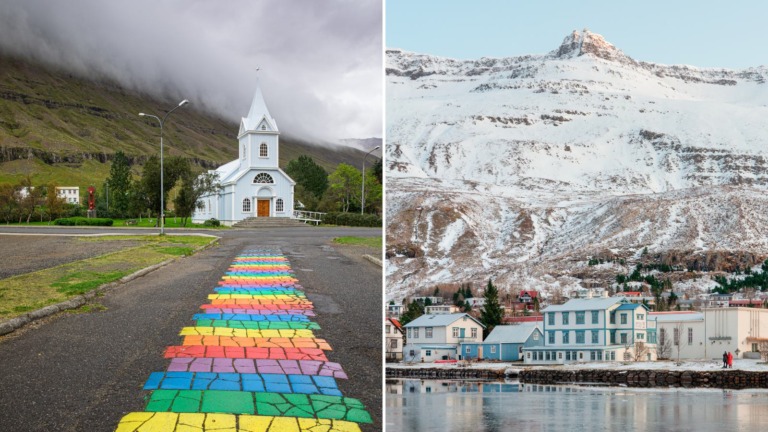
The tranquillity of the Eastfjords is matched by its wildlife. Reindeer, introduced in the 18th century, are frequently spotted grazing in the highlands and occasionally near the coast. The region is also a haven for seabirds, including puffins, while seals can often be seen sunning themselves on offshore rocks.
One of the highlights of the Eastfjords is the town of Seyðisfjörður, located at the innermost point of one of the most scenic fjords in the region.
Accessible via a dramatic mountain pass, this charming town is known for its colourful 19th-century wooden houses, many of which were originally imported from Norway. Seyðisfjörður has a thriving arts scene, with galleries, artist residencies, and cultural festivals that give the town a creative, bohemian character.
Seyðisfjörður also serves as a gateway to the Skálanes Nature and Heritage Reserve, a remote conservation area where hikers can explore wildflower meadows and coastal cliffs.
Iceland's South Coast
Iceland’s accessible South Coast is one of the most visually striking regions in the country, making it a popular choice for travellers on a short itinerary. A road trip reveals a constant stream of dramatic natural wonders within easy reach of the main Ring Road.
Among the most iconic sights are Seljalandsfoss and Skógafoss, two powerful waterfalls that offer very different experiences.
Seljalandsfoss tumbles over a high cliff with a walking path that allows visitors to circle behind the curtain of water. Further east, Skógafoss impresses with its sheer power and perfect symmetry, often accompanied by vivid rainbows on sunny days.
Continuing along the coast, the landscape shifts from green farmland to the surreal black sands of Reynisfjara Beach. Backed by towering basalt columns and sea stacks rising from the surf, Reynisfjara is both beautiful and forbidding.
The crashing waves and stark scenery make it one of Iceland’s most photographed locations, but caution is advised due to powerful “sneaker waves” that can strike without warning.
Just beyond Reynisfjara lies the small village of Vík í Mýrdal. With its red-roofed church overlooking the ocean and dramatic cliffs nearby, Vík provides a quiet base for exploring the area.
Westman Islands
The Westman Islands offer a blend of natural beauty, history, and wildlife. This archipelago of 15 islands is accessible by ferry or a short domestic flight, with most visitors heading to Heimaey, the largest and only inhabited island in the group.
Heimaey is known for its volcanic landscapes and the historic Eldfell eruption of 1973. Visitors can explore the Eldheimar Museum, which tells the story of the eruption and its impact on the local community.
The islands are also a prime spot for puffin watching, with large colonies of these charming birds nesting on the cliffs during the summer months. In fact, the Westman Islands are home to one of the world’s largest puffin colonies.
Arctic Adventures in Northern Iceland
Iceland's northern regions offer a range of Arctic adventures, from whale watching in Husavik to exploring the remote wilderness of the Arctic Circle.
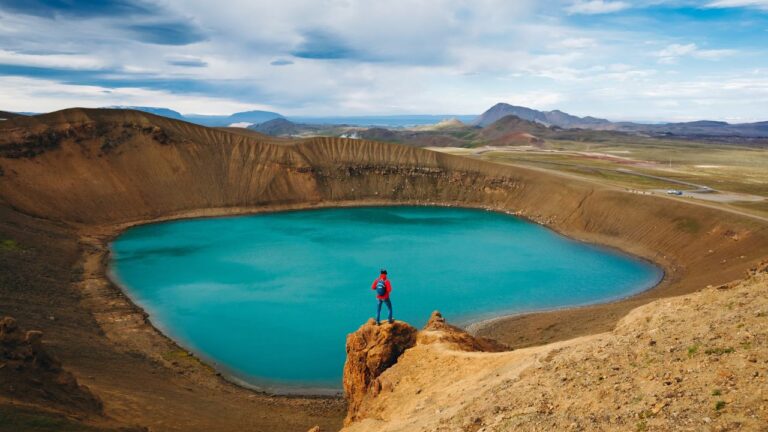
Husavik, often called the “Whale Watching Capital of Europe,” offers boat tours to see these majestic creatures in their natural habitat. The town also features the Husavik Whale Museum, which provides insights into the marine life of the area.
For those seeking a more remote adventure, the Arctic Circle area offers opportunities for hiking, wildlife watching, and experiencing the midnight sun during the summer months.
Lake Myvatn
Located in North Iceland, Lake Myvatn and surrounding region are known for their geothermal features, abundant birdlife, and striking landscapes.
Highlights of the area include the Myvatn Nature Baths, a geothermal spa with milky-blue waters, and the Hverir geothermal area, known for its bubbling mud pots and steam vents.
The nearby Dimmuborgir lava fields offer surreal landscapes of twisted lava formations, while the Krafla volcanic area features a dramatic crater lake and volcanic vents.
The Northern Lights
One of Iceland's most famous natural phenomena is the Northern Lights, or Aurora Borealis. This dazzling display of lights can be seen from various locations across the country, particularly during the winter months.
🇮🇸 Iceland Travel Resources: If you're planning a trip to Iceland, whether from Norway or something else, check out these recommended resources.
🛏️ Hotel Bookings in Reykjavik and beyond
🚘 Car Rental to explore the wonders of Iceland
👣 Tours & Experiences to make the most of limited time
🚨 Travel Insurance in case the worst should happen
Popular spots for viewing the Northern Lights include Thingvellir National Park, the Snaefellsnes Peninsula, and the remote areas of the Westfjords and Highlands.
For a more comfortable experience, consider staying in a glass igloo or a remote cabin with large windows, allowing you to watch the lights from the warmth of your accommodation.
Which are your favourite places to visit in Iceland? Or perhaps you haven't yet been but have been inspired to plan a trip? I'd love to hear your thoughts down in the comments.

